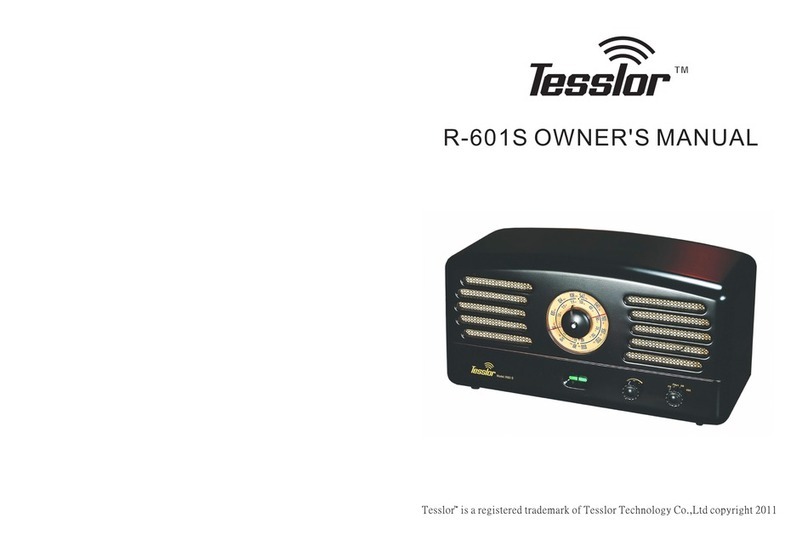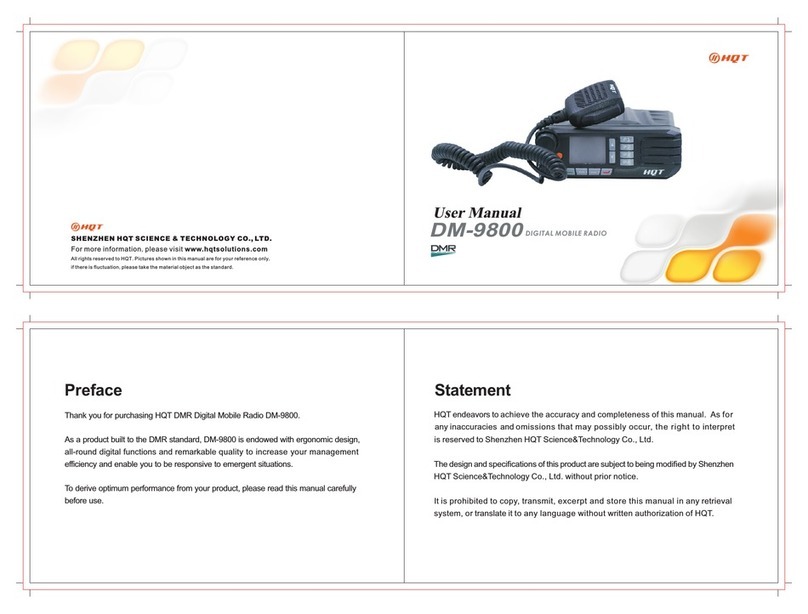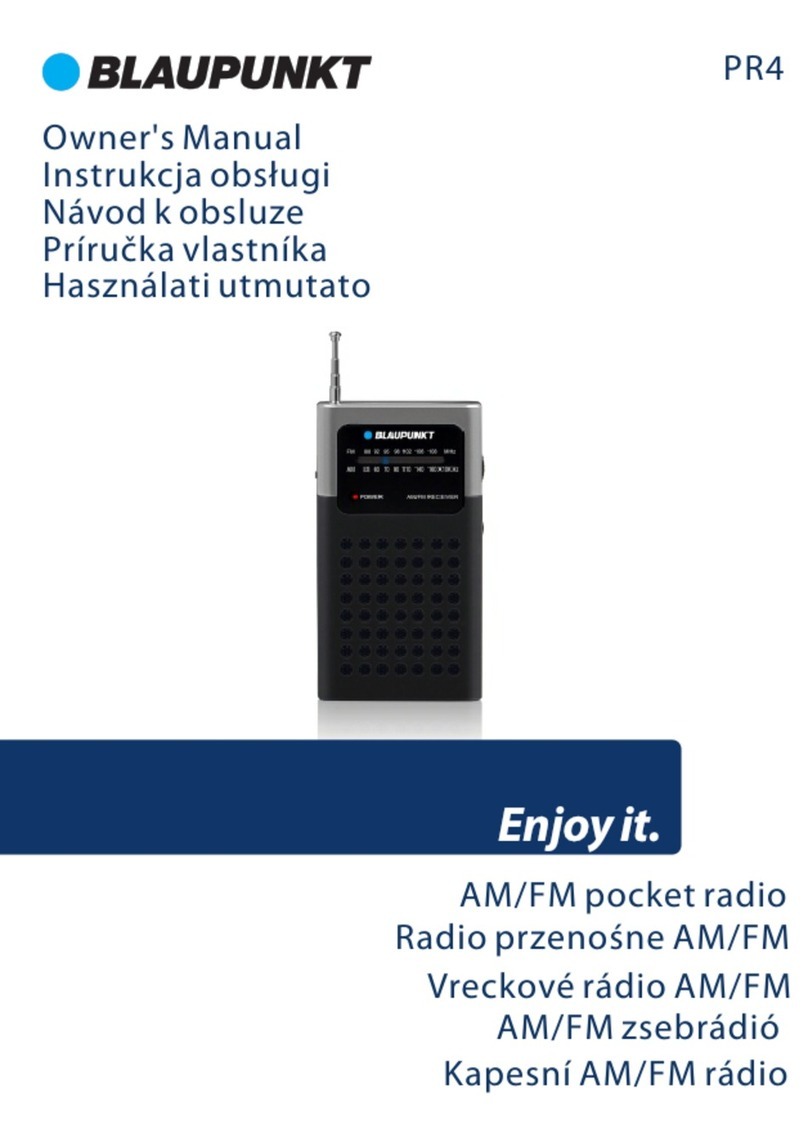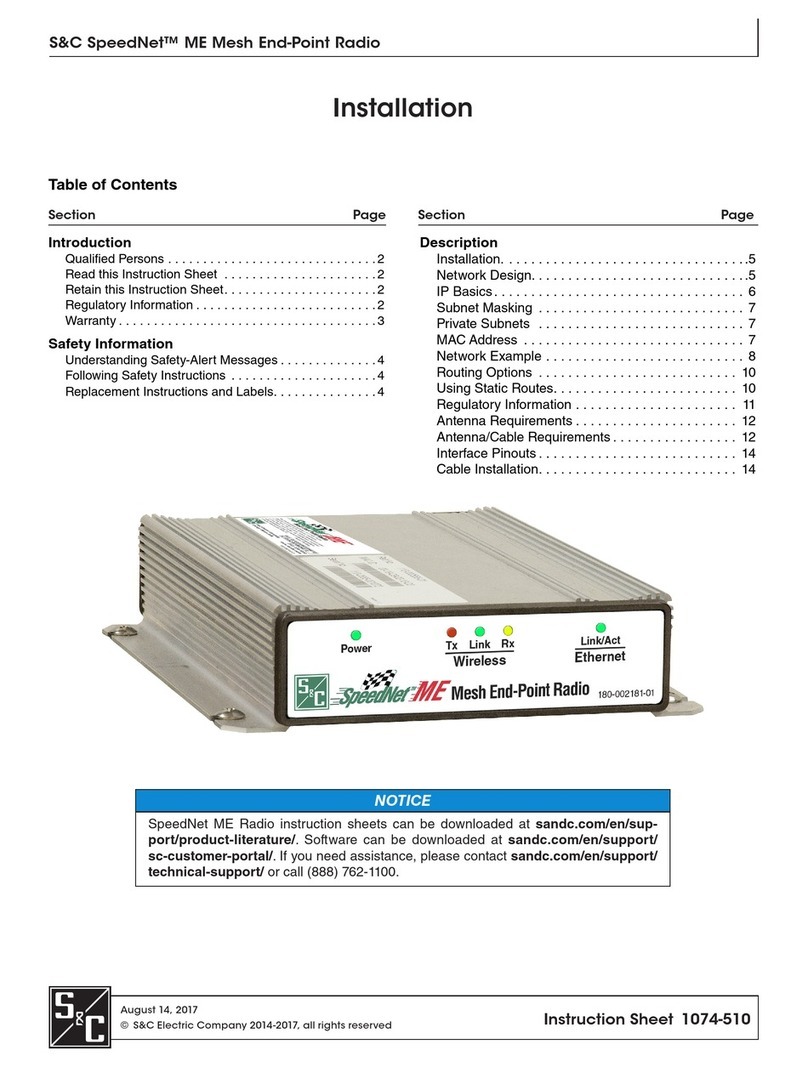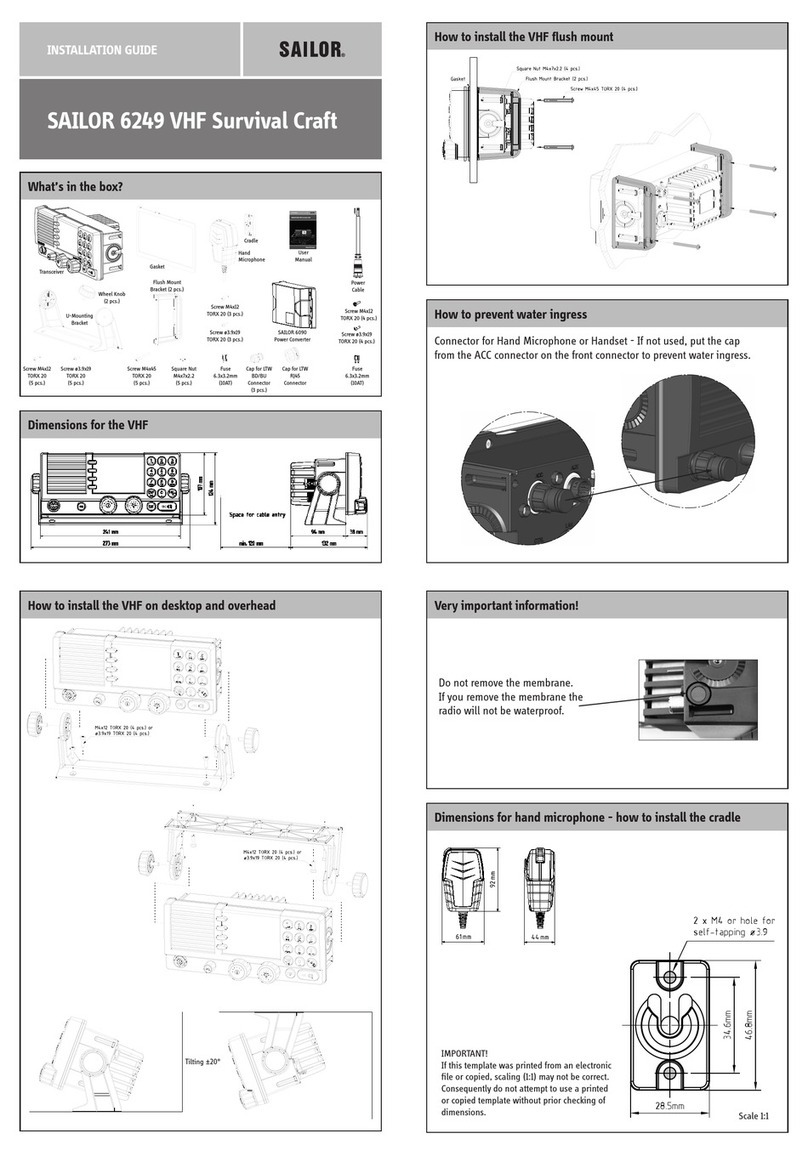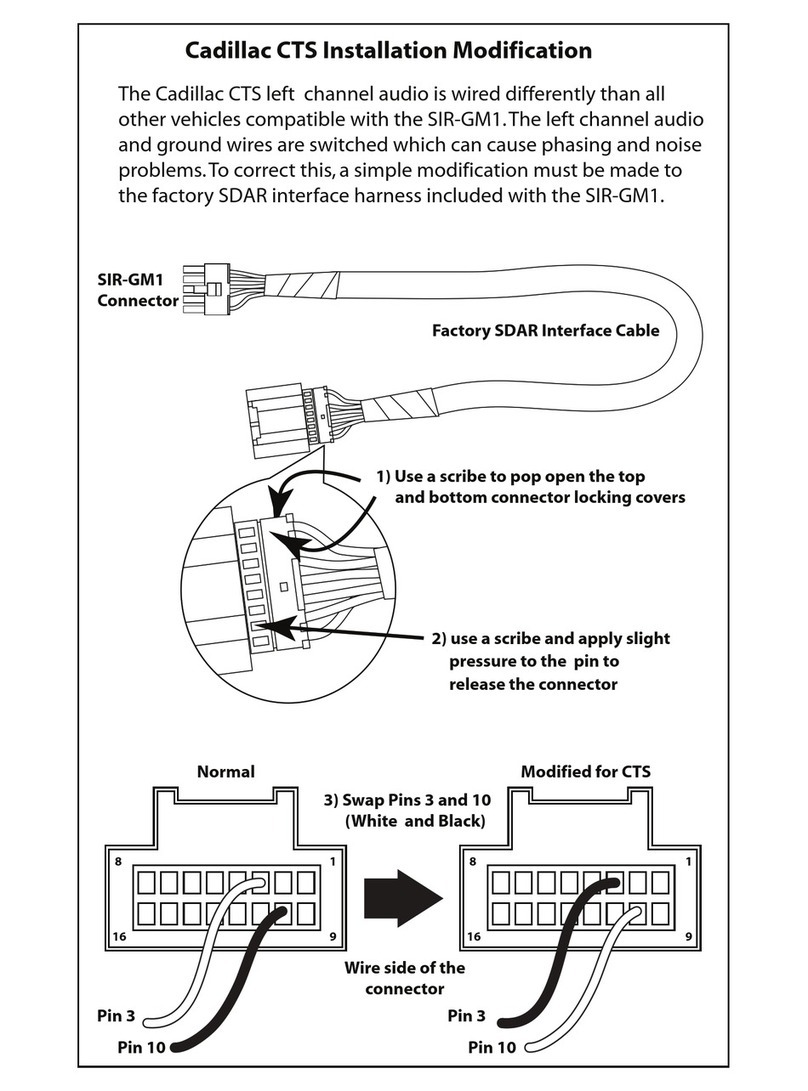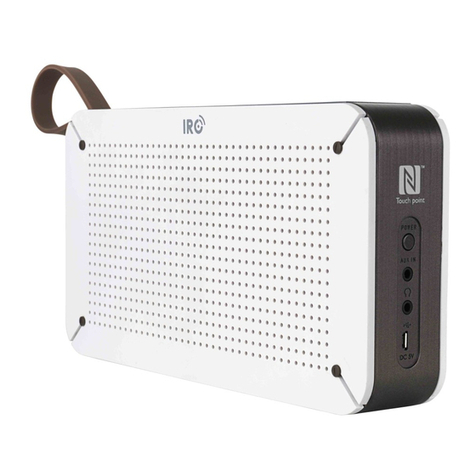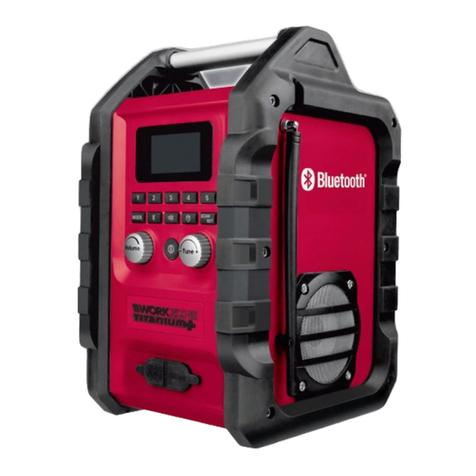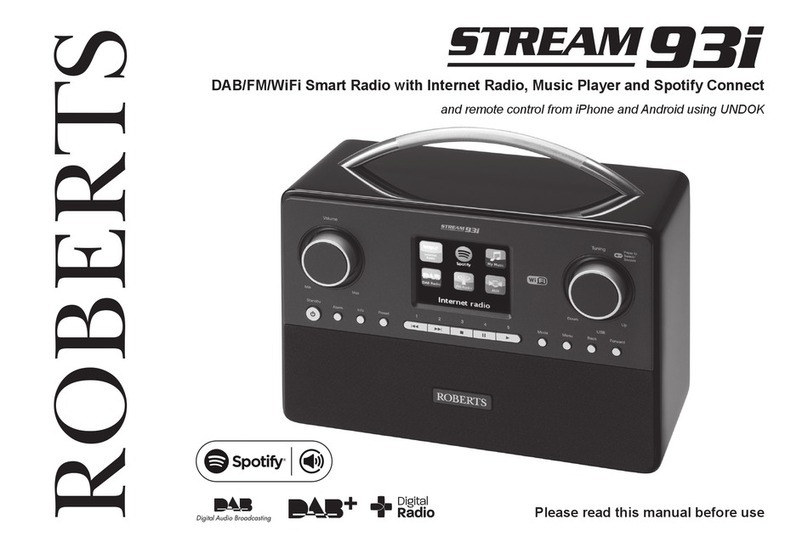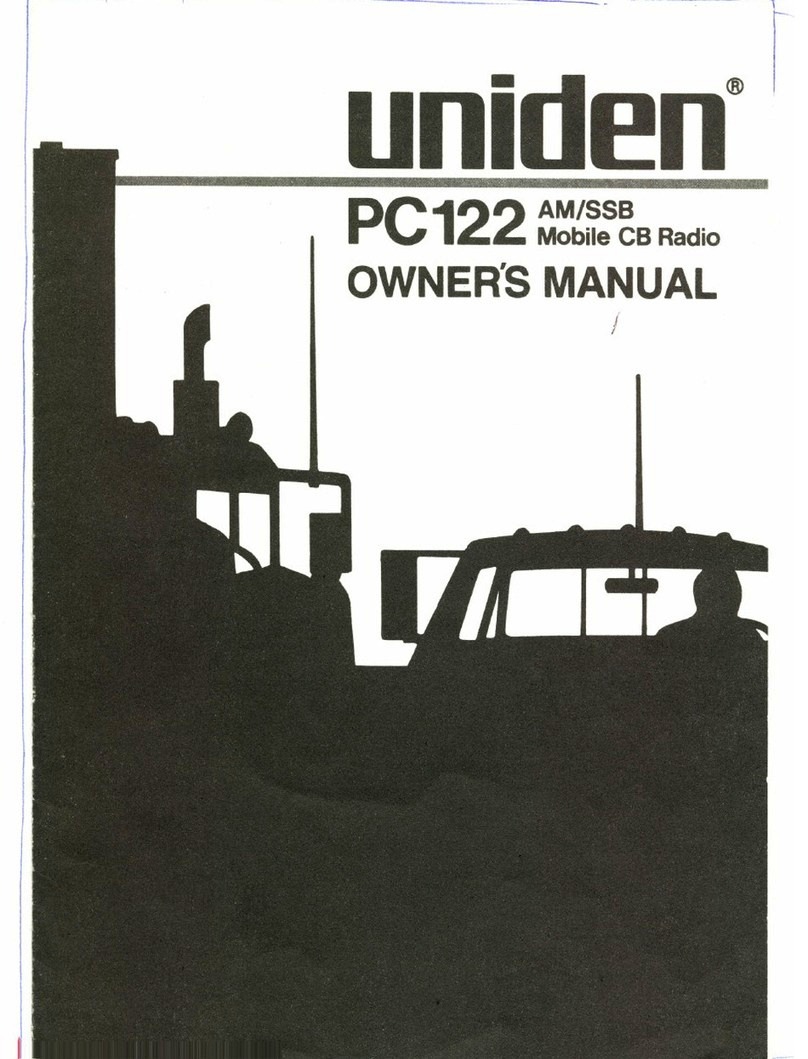Tesslor Technology R-301 User manual

R-301 Classic Radio
Owner’s Manual
Tesslor Technology Co.,Ltd
Copyright 2012
TM

15
2
Caution Statements
CAUTION: TO PREVENT ELECTRIC SHOCK, DO NOT USE THE THREE WIRE CORD WITH AN
EXTENSION CORD RECEPTACLE OR OTHER OUTLET UNLESS THE BLADES CAN
BE FULLY INSERTED TO PREVENT BLADE EXPOSURE
ATTENTION: POUR PREVENIR LES CHOCS ELECTRIQUES, NE PAS UTILISER CETTE FICHE
POLARISE AVEC UN PROLONGATEUR, UNE PRISE DE COURANT OU UNE
AUTRE SORTIE DE COURANT, SAUF SI LES LAMES PEUVENT ETRE INSEREES
A FOND SANS EN LAISSER AUCUNE PARTIE A DECOUVERT.
!WARNING!
WARNING: TO REDUCE THE RISK OF FIRE OR
ELECTRIC SHOCK
DO MOT REMOVE COVER (OR BACK)
NO USER-SERVICEABLE PARTS INSIDE
REFER SERVICING TO QUALIFIED PERSONNEL
WARNING: TO PREVENT FIRE OR
ELECTRICAL SHOCK DO NOT
EXPOSE TO RAIN OR MOISTURE
WARNING: TO REDUCE THE RISK OF FIRE OR ELECTRIC SHOCK, DO NOT EXPOSE THIS
APPLIANCE TO RAIN OR MOISTURE.
The lightning flash with arrow head symbol, within an
equilateral triangle, is intended to alert the user to the
presence of uninsulated dangerous voltage within
the product s enclosure that may be of sufficient
magnitude to constitute a risk electric shock to persons
An appliance and cart combination should be moved
with care. Quick stops, excessive force and uneven
surfaces may cause the appliance and cart combination
to overturn.
The exclamation point within an equilateral triangle
intended to alert the user to the presence of important
operating and maintenance (servicing) instr uctions in
the literature acconpanying the appli-ance
is
,“ ”
High Voltage
Your radio tubes operate using high voltage. Do not attempt to adjust, repair or fix your
radio. Do not remove the rear case as there are no owner-serviceable parts inside the
case. Should you need service, please contact your Tesslor dealer or an experienced local
electronics repair facility.

14 3
Safety Information
1. Read instructions – all the safety and operating instructions should be read before the
product is operated.
2. Retain Instructions–the safety and operating instructions should be retained fo future
reference.
3. Heed warnings – all warnings on the product and in the operating instructions should
be adhered to.
4. Follow instructions – all operating and use instructions should be followed.
5. Cleaning – unplug this product from the wall outlet before cleaning. Do not us liquid
cleaners or aerosol cleaners.
6. Attachments – do not use attachments that are not recommended by the product
manufacturer as they may cause hazards.
7. Water and Moisture – do not use this product near water, for example, near a bathtub,
wash bowl, kitchen sink or laundry tub. Do not use it in a wet basement, near a
swimming pool and the like.
8. Accessories – do not place this product on an unstable cart, stand, tripod, bracket or
table. The product may fall, causing serious injury to a child or adult, and serious
damage to the product. Any mounting of the product should follow the manufacturers
instr uctions.
9. Antennas – use only the antennas recommended by the manufacturer and exercise
extreme care and caution in placing the antenna in a safe and stable location. Antenna
cords inside the home should be carefully mounted to prevent access and injury to
children. External antennas must be mounted and installed using the antenna
manufacturers specific instructions.
10. Ventilation – slots and openings on the product are provided for ventilation and to
ensure reliable operation of the product and to protect it from overheating. These
openings should never be blocked or covered. The openings should never be blocked
by placing the product on a bed, sofa, rug, or similar surface. The product should not
be placed in a built-in installation such as a bookcase or rack unless proper ventilation
is provided or the manufacturer's instructions have been adhered to.
11. Power Source – this product should be operated only from the type of power source
indicated on the marking label. If you are not sure of the type of power supplied to
your home, consult the product dealer or local power company.
12. Grounding or Polarization – this product is equipped with a polarized alternating
current type plug. This is a safety feature designed to ensure the product correctly
attached to your power source and your ground. If the plug does not fit your outlets,
locate the product near a compatible outlet or consult with a qualified electrician
regarding your power source and outlets. Do not defeat the purpose the polarization
and grounding safety features.
13. Power Cord Protection – your power cord should be routed in a manner to ensure it is
not pinched by other items or furniture and not walked on. Pay particular attention to
ensure the power cord is fully inserted into the product and that the cord is not bent or
pinched where the cord exits the product.
14. Outdoor Antenna Grounding – if an outside antenna or cable system is connected to
the product, be sure the antenna or cable system is grounded so as to provide some
protection against voltage surges and built-up static charges. Article 810 of the
National Electrical Code, ANSI/NFPA 70, provides information with regarding to
proper grounding of the mast and supporting structure, grounding of the lead-in wire
to an antenna discharge unit, size of grounding electrodes, and requirements for the
grounding electrode.
To Zeng, a high quality radio, like the ones many people grew up with, have a special place in
their heart. In China, the famous wood radios of the past were brands like Panda, Red Lantern
and Shanghai and are similar to the overseas brands like Grundig and Telefunken. Zeng still
owns the vintage Kaige 455D tube radio he purchased in 1971 along with its original receipt
and the radio remains a prized possession to him and his family even today. While he had
thought many times of designing and manufacturing radios, it was during an invitation to a
Guangdong radio station interview, where he saw many vintage radios on display that he
decided to start work on a new model.
That decision was the start of a new chapter in Zeng's life and a long journey that brings us to
today's Tesslor brand of radios. Since Zeng had set a very high standard for himself and his
products, the process of developing the new radios faced many obstacles, much trial and error,
many special circuit designs, many technical challenges solved and the awarding of several
patents along the way. As new models rely heavily on R&D costs, special tooling, and special
manufacturing processes, even small items such as knobs, buttons and small parts must be
made from scratch in small batches and at a high cost.
The result of Zeng's exceptional vision and efforts is a line of ten products unlike anything in
the marketplace. The designs, philosophy, technology and manufacturing process are a
blending of old and new. Even the 60 day-long process of forming, curing and finishing the
wood cabinets is from another age. It's almost as if Zeng somehow reached back to the time
of his youth to craft a radio that spans two different eras. In doing so, Zeng has created a
product that has the spark of the modern age but the soul of a vintage radio.
Unlike mass produced consumer products, your Tesslor radio is truly hand crafted. They are
made by people who hope they become as prized a possession as the beautiful wood radios of
the past. In a world where consumers know little about the people who make the things they
use, we share this story of Zeng and his vision to produce something unique and beautiful. We
hope you enjoy your Tesslor radio as much as the people whose passion brought these
products to life.

4
15. Lightning – for added protection for this product during a lightning storm, or when it is
left unattended and unused for long periods of time, unplug it from the wall outlet and
disconnect the antenna or cable system. This will prevent damage to the product due to
lightning and power-line surges.
16. Power Lines – an outside antenna should not be located in the vicinity of overhead power
lines, other electric light or power circuits, where it can fall into such power lines or
circuits. When installing an outside antenna system, use extreme care to prevent the
installer or antenna from touching power lines or circuits, as contact with them may be
fatal.
17. Overloading – do not overload wall outlets, extension cords, or power outlets as this can
result in fire or electric shock.
18. Object and Liquid Entry – never push objects of any kind into this product through the
openings as they may touch dangerous voltage points or short-out parts that could result
in a fire or electric shock. Never spill liquids of any kind on the product. Prevent any
flammable materials, such as curtains, drapes or other materials from being positioned on
or near the product.
19. Ser vicing – do not attempt to service this product yourself as opening or removing covers
may expose you to dangerous voltage and other hazards. Refer all servicing to qualified
service personnel.
20. Damage Requiring Service – unplug the product from the wall outlet and refer servicing
to qualified service personnel under the following conditions:
a. When the power-supply cord or plug is damaged
b. If liquid has been spilled, or objects have fallen into the product.
c. If the product has been exposed to rain or water.
d. If the product does not operate normally when following the operating instructions.
e. If the product has been dropped or damaged in any way
f. When the product exhibits a distinct change in performance. This indicates the need
for ser vice.
21. Replacement Parts – when replacement parts are required, be sure the service technician
has used replacement parts specified by the manufacturer or have the same characteristics
as the original parts. Unauthorized substitutes may result in fire, electric shock and other
hazards.
22. Safety Check – upon completion of any service or repairs to this product, ask the service
technician to perfor m safety checks to determine that the product is in proper operating
condition.
23. Heat – the product should be located away from heat sources, such as radiators, heat
registers, stoves, or other products (including amplifiers) that produce heat.
NOTE TO CATV SYS TEM INSTALLERS :
THIS REMI NDER IS PROVIDE D TO I CALL THE
CATV SYSTEM IN STALL ER’S ATTENTION T O
ARTIC LE 820-40 O F THE NEC THAT
PROVIDES GUID ELINES FO R PROPE R
GRO UNDING AN D, IN PARTIC ULAR,
SPECIFI ES THAT THE CABLE GROUN D
SHALL BE CO NNECTED T O THE
GRO UNDING SY STEM OF THE BUILDING,
AS CLOSE TO T HE POINT OF C ABLE ENTRY
AS PRACTIC AL
Figur e A
Example o f an tenna groundi ng as per Natio nal Elect rical Code, ANSI/NFPA 70
ANTENNA
LEAD IN
WIRE
ANTENNA
DISCHARGE UN IT
(NEC SECT ION 810-2 0)
GRO UNDING CO ND UCTORS
(NEC SECT ION 810-2 1)
GRO UND CLAMP S
POWER SERVI CE G ROU NDING
ELECTRODE SY ST EM
(NEC SRT 250,PART H)
GRO UND CLAMP
ELECTRI C
SERVICE
EQU IPMENT
13
Zeng DeJun is a well-known name in the Chinese audio industry where his reputation as a
designer, teacher, entrepreneur and business man is legendary. He's the designer of China's
first Hi-Fi vacuum tube amplifier, a founding member of the nation's Hi-Fi vacuum tube
industry and designer of many lines of hi-end multimedia speakers and numerous Hi-Fi
products with cult followings in Asia. In 1994, Zeng founded the Shenzhen V.A.L.
Technology Co., Ltd. to finally pursue a lifetime goal of manufacturing a line of unique Hi-Fi
retro radios based on the classic wooden receivers of his youth that first kindled his love of
radio.
Some of Zeng's earliest memories as a child are of the beautiful wood radios in his home that
brought voice and music and sparked his curiosity towards science and technology. He recalls
that as a young child he asked how such a box could do such magical things but received no
clear answer. One day, when no others were around, he opened the back cover of the radio but
could not find the small people he had imagined were inside. All he saw were the glowing
bulbs (tubes) and lumps of iron (transformers). His parents couldn't explain how the radio
worked and told him that when he grew up and studied, he would be able to understand.
Thus began Zeng's lifetime love and curiosity in radio and science. In school and led by
teachers and others, he began to assemble simple crystal radios and more sophisticated
versions. Growing up in a remote area, radio was both the fastest and most effective way to
learn of news and information from the outside world. Later, as a new recruit in the Army, he
found and repaired a faulty transistor radio for a superior who was so impressed that he gave
Zeng the option of choosing the specialty for which he'd receive advanced training. Zeng
chose the communications corp where he was quickly trained for radio communications.
Always curious and inventive, he found existing military radios heavy and outdated so he set
about designing and building lightweight versions that earned him an Outstanding Innovation
Award and a transfer to the army research institute. Later, he was sent to Beijing Aviation and
Aeronautics University to study, after graduation he became a senior engineer and lecturer in
the Army and a new phase of his life began.
Over many years and many changes in his life, Zeng found radio programming and music to be
a close companion that gave him strength to pass difficult times and challenges. Having spent
many years in the audio industry, Zeng is familiar with high quality music systems and CD
players but prefers the fresh music selection and information found on radio. He prefers to
work in an office with a good table radio and, in part, this is one reason why he dreamed of
designing and manufacturing a quality radio set like the ones he recalled from his youth.
Having designed and built the first commercial Hi-Fi vacuum tube amplifiers as well as the Hi-
End brand of V.A.L. tube amplifiers, he had often thought of designing high quality table
radios, and saw this as an area no other companies had pursued.
The Tesslor Story

12 5
DO NOT submerge or expose any part of this product to water or other liquids. Components
are NOT water resistant and will be damaged by water.
For best long term results, turn on your radio at least once a month and operate it for at least
one hour to heat the circuits and remove internal moisture that may have accumulated from
long periods of inactivity.
Proper ventilation of the radio is important for safe operation. Ensure that the radio is placed
in a dry location where it is well ventilated during operation.
If the radio is being returned to service after long term storage, place it in a dry and well
ventilated location for several days before attempting to operate it. Moisture inside radio
circuits is know to cause electrical short circuits. Should your radio ever make a hissing sound,
or you see sparks or other signs of an electrical problem, unplug the radio and consult a
qualified repair person for assistance. Never attempt to open, inspect or repair the radio
yourself.
KEEP AWAY FROM CHILDREN
Components may contain small parts that can be broken and disassembled or components,
cords, antennas or other parts may become loose or exposed. Small parts and packaging
materials may become a choking hazard for small children.
HIGH VOLTAGE
This product uses household current and high voltage. There are no user serviceable parts
inside the cabinet. DO NOT OPEN THE REAR CABINET FOR SERVICING OR
ADJUSTMENT. ONLY QUALIFIED PROFESSIONAL REPAIR ORGANIZATIONS
HAVE THE TOOLS AND TRAINING TO SERVICE THE PRODUCT.
Disclaimer
How Do I Improve Radio Reception?
The most common issue with radio reception is related to the location of the radio receiver
and the use of the proper antenna. If you experience weak signal reception, try using both the
internal antenna and the supplied external antenna. Be sure to select the correct antenna using
the AM or FM antenna selector switches located on the rear of the cabinet. Try adjusting the
location and orientation of your antenna. Also, try moving your radio to a location where you
receive stronger signals. For optimum performance, consider an external FM antenna for peak
signal reception. See your dealer for additional antenna options.
How Do I Use An MP3 Player With My Radio?
To use an external audio player, you will need an adapter cable for your MP3 player, PC or
other audio device (not included). The rear case of the radio has an AUX IN jack (RCA female
jack) where you will connect the adapter cable from your audio source. Turn the Band switch
on the side of the radio to the AUX position and carefully adjust the volume level of your
audio source for prevent distortion as your audio device is amplified by the radio's amplifier
and played from the radio speaker.
FAQ
Troubleshooting
Trouble Symptom Possible Causes Solutions
No sound
Distorted
Audio
Noisy
Audio
1. Check on/off/volume knob
2. Check that power cord is fully
inserted.
3. Replace blown fuse
4. Tune other stations, check
antenna, check antenna selector
switch
5. Contact technician for repair
1. Fine tune station signal
2. Adjust volume
3. Check antenna connection, try
internal or external antenna
1. Wrong antenna
selected
2. Interference from
nearby electronic
device
3. Internal failure
1. Backlight does not
work
2. No signal or weak
signal
Noisy or scratchy
audio
1. Hissing or buzzing
sound
2. Unable to find clear
signal
1. Double check antenna connection
and antenna selector switch, use
external antenna.
2. Switch off or move radio away
from nearby electronic device
3. Contact technician for repair
1. Station not tuned
correctly
2. Volume too high
1. power turned off
2. power cord loose
3. Fuse blown
4. Wall outlet not
working
5. Internal failure

6
Caution Statements 2
Safety Information 3-4
Disclaimer 5
Table of Contents 6
Introduction and General Description 7
Specifications 8
Controls Overview 9
Rear Panel Connections 10
Basic Operation 11
FAQ 12
Troubleshooting 12
The Tesslor Story 13-14
Table of Contents
11
Turning On and Off
Turn the timer switch on the right side to turn your radio ON. You will hear a click indicating
that the switch has been turned on or off. The radio main dial backlight will illuminate and you
can hear the sound.
Adjust the volume control clockwise to increase volume and counter-clockwise to reduce
volume. To turn the radio off, turn the time switch to the OFF position. You will hear a click
as the radio turns off. The radio dial backlight will turn off.
Band Switch
Select AM or FM using the band selector switch. In the AM position, the radio will receive AM
stations (520 – 1710 KHz). In the FM position, the radio will receive the FM band (87.5 – 108
MHz). The AUX position is used to play external audio sources connected to the radio using
the rear-mounted AUX IN socket (such as PC, CD or MP3 players). When you connect the
right channel speaker (Not included) and the radio station you receive is broadcasting in
Stereo mode, you can enjoy Stereo sound by selecting the FM Stereo position..
Select your desired band and then adjust the Main Tuning Knob to receive your desired
station.
Tuning Desired Stations
The Main Tuning Knob is used to tune and search for radio stations on the selected band.
Adjust the Knob to receive the desired station. Note that FM stations are referenced on the
LEFT side of the main dial using the RED line on the LEFT side of the Main Tuning Knob.
When receiving AM stations, refer to the RIGHT side of the main dial using the RED line on
the right side of the Main Tuning Knob.
Basic Operation
FM external antenna mounting position

10 7
Thank you for selecting Tesslor products. We strive to produce the best sounding classic radio
receivers available anywhere. With proper care, your radio will provide many years of reliable
service.
This manual provides an overview of your new radio and includes many IMPORTANT safety
and operating notices. Please take a few minutes to read it fully and familiarize yourself with
your new radio. Also remember to register your radio to activate your warranty.
General Description
Your Tesslor radio combines the best of modern electronics and classic design to produce a
radio receiver with superior audio performance.
Where radio manufacturers in the 1940's and 1950's produced many fine quality radios using
tubes, your Tesslor takes advantage of modern electronic component to improve radio
reception sensitivity, selectivity and rejection of interference. Combined with specially
designed power amplifier and speakers, your Tesslor produces an uncommon level of audio
perfor mance not found in modern radios.
Your Tesslor radio incorporates modern electronics for the analog receiver circuitry and adds
specially designed power amplifier to mimic the war mth of a vintage tube radio. The amplifier
is matched to a high-quality speaker to ensure you experience the war mth and resonance
produced by the vacuum tubes.
The receiver's RF circuit design includes a number of state-of-the-art innovations designed to
provide improved sensitivity while maintaining sharp selectivity, resulting in unusually clear
reception for weak and remote stations. The tuner dial itself is finely engineered to provide a
strong tactile response when tuning, resulting in a very smooth and positive rotation to assist
station selection.
Front panel controls include the radio’s volume control knob, a large, smooth-action tuning
knob with back-lit dial and bass/treble control knobs. The bass and treble controls permit
fine tune of the music balance. Band Switch located on the right side panel permits you to
select the AM, FM radio band or the Auxiliary input. The Auxiliary input permits you to
connect a digital music player or other audio source into your Tesslor radio for amplification.
A mechanical timer is provided for automatic shut-off at pre-defined time schedule.
Internally, your Tesslor radio incorporates electronic shielding to isolate and prevent potential
interference and improve radio performance.
Controls on the radio's rear panel include two slide switches to select internal or external AM
and FM antenna options, RF jacks for audio input and a 3.5mm audio headset jack. Antenna
jacks on the rear case include an RF jack for the included AM external antenna and an F-
connector jack for the included external FM dipole antenna. A stereo speaker output is
provided to connect a matching right-channel speaker to enjoy radio programs and other audio
sources in stereo.
Introduction and General Description
Power Socket
Plug your wall outlet cord into the radio. Press firmly to
ensure a good connection. Note that your wall cord is a
polarized and grounded cord. For safety, always use a
grounded wall outlet with this radio.
AM Antenna
Select Switch
(external / internal)
Selects either the built-in internal antenna or the external
antenna. When placed in the external position, the supplied
AM loop antenna should be attached to the adjacent AM
antenna jack.
External AM Antenna
RCA female jack for connecting the external AM loop antenna.
Use the external AM antenna for best reception results.
Adjust the antenna location for optimum signal reception.
FM Antenna
Select Switch
(external / internal)
Selects either the built-in internal antenna or the external
antenna. When placed in the external position, the supplied
FM dipole antenna should be attached to the adjacent FM
antenna jack.
External FM Antenna
F jack for connecting the supplied external FM dipole antenna.
When using the dipole antenna, securely attach the antenna
connector, extend the antenna to its full width and adjust the
position for best signal reception.
REC OUT For connecting the received audio signal to an external
source for recording or other use.
AUX IN
For connecting external PC, CD or MP3 players. When using
this connection, turn the front panel band switch to the AUX
position to permit the radio to amplify and play external
audio sources.
Headphone
For connection of headphones. When this 3.5mm jack is
connected to headphones, the front facing speaker is
disconnected to permit private listening.
Rear Panel Connections
Figure 2
Rec out
Aux in
Headphone
AM antenna
Select Switch
Power Socket
FM antenna
Select Switch
FM antenna
AM antenna
Stereo Speaker out

8
9
FM Band: 87.5 MHz-108 MHz
AM Band: 520 KHz-1710 KHz
S/N Ratio: FM >50dB, AM > 40dB
Noise Sensitivity: FM < 16 dB (s/n=30 dB); AM < 60 dB (s/n=26 dB)
Distortion: FM < 0.5%, AM < 1%
Single Signal Selection: > 30 dB
Output Power: >2 x20W
Frequency Response:30Hz-20KHz
Speaker Unit: 4”+ 1”
Speaker Impedance: 4Ω
Frequency Response: 70 Hz-16 KHz
Inputs: Antenna In & Aux In
Outputs: Headphone, Right Channel Stereo Speaker
Product Size: 37(L) x 14.5(W) x 21(H) cm
Features:
High fidelity audio
FM / AM band operation
Rich and warm sound
Audio input from external sources (PC, CD, MP3 players)
Headphone jacks
Selectable internal or external antennas for both AM and FM reception
MDF wood enclosures
High quality smooth tuning main dial and backlit panel
Mechanical timer function
Unique, uncommon, classic & elegant appearance
PVC finish reminiscent of 1950's classic designs
Packing List:
Radio
Power Cord
User Manual and Warranty Card
External FM dipole antenna
External AM loop antenna
Spare fuse
Specifications
Timer and Power Switch
Set the timer switch to ON to turn on the radio. Set the timer to indicated minutes permits the
radio to operate for a pre-defined time before automatically turns off. When the timer is active
it produces a clicking sound from its internal gears, the sound is weak and in normal volume
will not interfere with listening . You can defeat the timer sound by setting it to the ON
position and use external power switch to turn off the radio
Volume Control
The volume control serves to adjust the volume level of the radio, adjust the volume control
clockwise to increase volume and counter-clockwise to reduce volume.
Band Switch
The band selector switch is used to select the AM, FM or AUX functions. In the AM position,
the radio will receive AM stations (520 – 1710 KHz). In the FM position, the radio will receive
the FM band (87.5 – 108 MHZ). The AUX position is used to play external audio sources
connected to the radio using the rear-mounted AUX IN socket(such as PC, CD or MP3
players). When you connect a right channel speaker (Not included) and the radio station you
receive is broadcasting in Stereo mode, you can enjoy Stereo sound by selecting the FM Stereo
position.
Tuning Knob
The tuning knob is used to tune and search for radio stations on the selected band. A precise
5:1 tuning dial is designed to fine tune weak signal and make long-distance listening much
easier.
Treble and Bass
Treble and Bass controls are provided to fine tune the music balance, suitable for different
audio sources and listening environment
Controls Overview
Volume control
Bass
Tuning Knob
Figure 1
Treble
Timer
Band Switch
Table of contents
Other Tesslor Technology Radio manuals
Popular Radio manuals by other brands

Radio Shack
Radio Shack 1200093 user guide
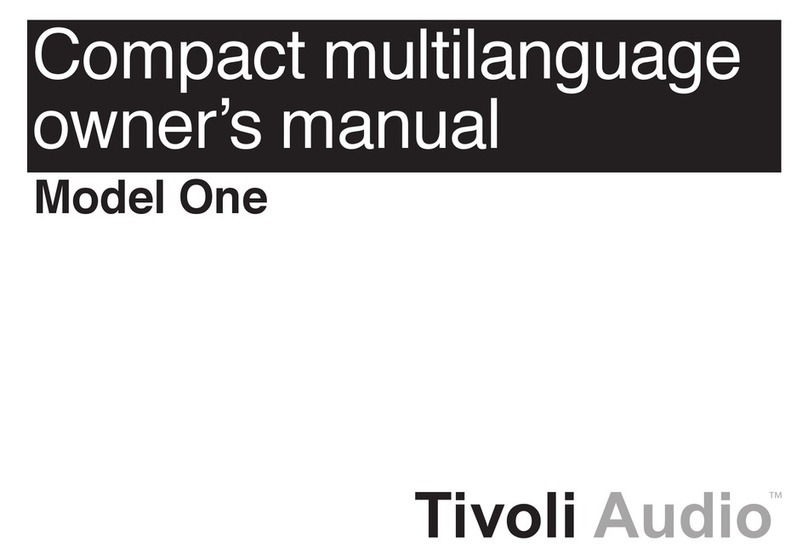
Tivoli Audio
Tivoli Audio MODEL ONE owner's manual

Custom Autosound Manufacturing
Custom Autosound Manufacturing Secretadio SRMS instructions
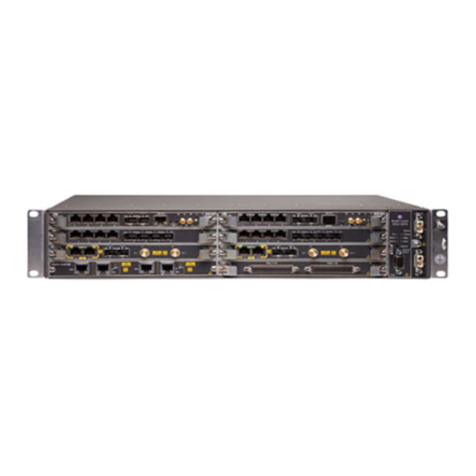
Alcatel-Lucent
Alcatel-Lucent 9558HC user manual

PRESIDENT
PRESIDENT MC KINLEY USA 12/24 V owner's manual
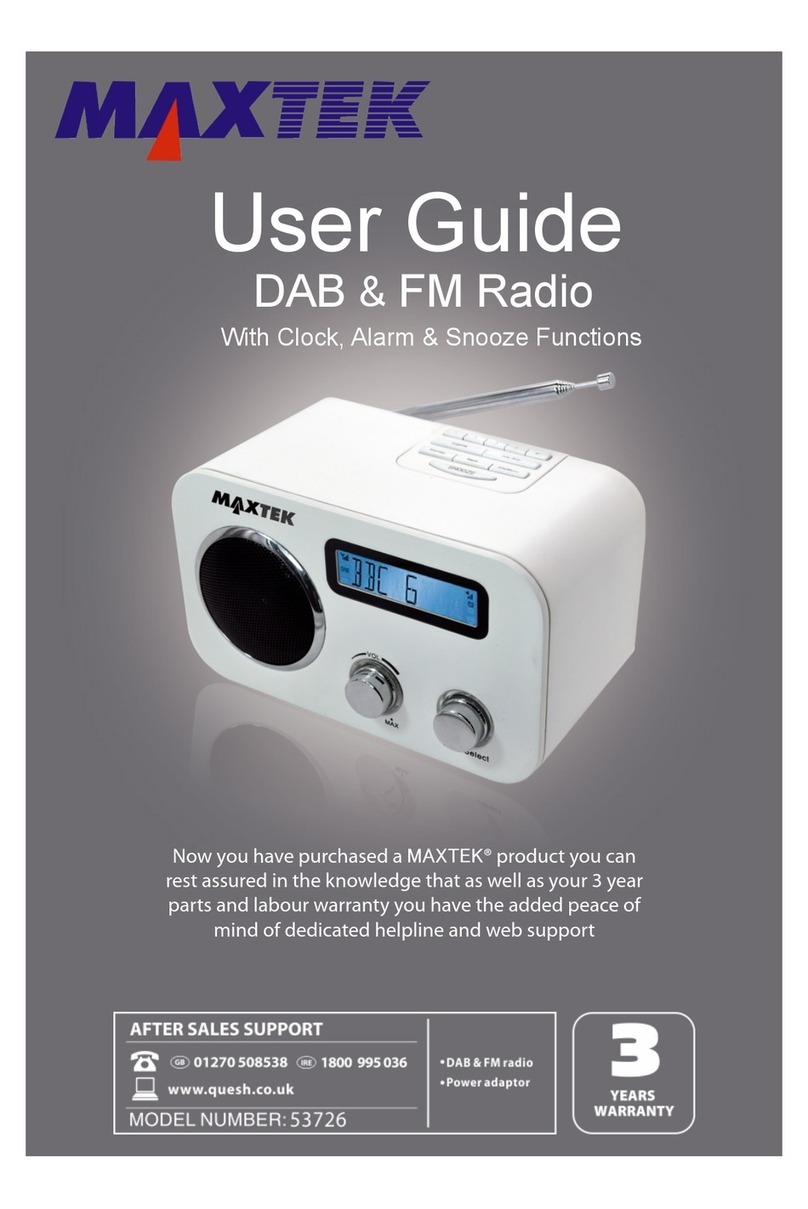
MAXTEK
MAXTEK 53726 user guide
